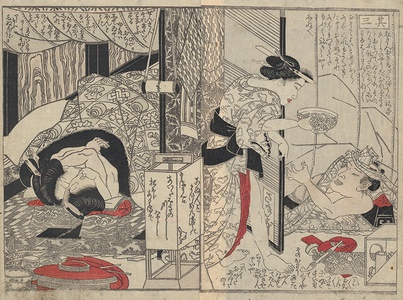| Method | Woodblock (nishiki-e) |
| Artist | Utagawa Toyokuni [Toyokuni I] (1769 - 1825) |
| Published | 1822 |
| Dimensions | Two Hanshibon sheets [each sheet ~222 x 155 mm] |
| Notes |
Series: Ōyogari no koe: Call of Geese Meeting at Night Writer: Piwihafu no Moemon pseudonym of Utei Enba II A print from Volume II of from Toyokuni I's three volume Ōyogari no koe: Call of Geese Meeting at Night. This series contains 26 images with short erotic stories written by Utei Enba II. An example of non explicit Shunga, in which two men visit two joro (sex worker). The two couples are in a room separated by a screen. On the right, a woman dressed in a butterfly patterned kimono brings water to her client Matsu man who is coming out from under a mosquito net, a scarf tied around his head, a pipe and a tobacco pouch lay near him. On the other side of the screen on the left a couple are embracing under a quilt, their heads on takamakuras (raised sleeping pillows) the woman tells the many although she lies with many men she only loves him. Shunga is the term used for the body of erotic imagery produced in Japan from 1600 to 1900. The term shunga means spring pictures, a euphemism for sex, and is one of several names for erotic material produced in Japan. Shunga took different formats: painted hand scrolls, painted books, printed books and albums, and sets of prints which were sometimes sold in wrappers. As prints they are one of the genres of ukiyo-e, or Floating World prints, which also include fukeiga (landscape prints), and bijin-ga (prints of beautiful women). Most of the major ukiyo-e artists produced shunga material at some point during their careers, including Utamaro (who produced more erotic books than non-erotic books), Hokusai, and Hiroshige. Produced at the same time as the introduction of full colour woodblock printing, shunga prints and books were made using the most lavish and complicated printing techniques, including gauffrage, metallic inks, mica, complicated printed patterns, and multicolour printing using a high number of different colours. Although prolific in its number and variety, shunga should be seen as more representative of the ideals of the ukiyo, with its emphasis on mutual pleasure, rather than as an accurate representation of Japanese attitudes and practices of sexuality. Shunga present an invitation to pleasure through the bliss of lovemaking and though largely heteronormative, they portray the full gamut of couplings, married or otherwise, often surrounded by lavish settings and objects of pleasure. Utagawa Toyokuni I (1769-1825) was one of the leading figures of Japanese woodblock printmaking. Born in Edo, he was the son of Kurahashi Gorobei an important carver of dolls and puppets specialising in kabuki figures. After showing talent at painting from a young age, Toyokuni was apprenticed to Utagawa Toyoharu (1735-1814) founder of the Utagawa School and a nearby neighbour. Toyokuni was a master of actor prints, but also specialised in bijin-ga. He trained Kunisada and Kuniyoshi and was a key figure the generating the prosperous early 19th century Edo ukiyo-e print market. Toyokuni produced a few shunga works in the 1790s but ceases to produce any more for a twenty year period until 1822 when he produced Oyogari no koe. It was after he produced this work that fellow Utagawa artists followed his lead and began to produce shunga. Utei Enba II (1792-1869) was an Edo author of popular fiction. He also wrote a number of successful erotic books which he produced in collaboration with members of the Utagawa School including Toyokuni I and Kunisada. The works he collaborated on contain numerous novel devices to entice and entertain readers such as the inclusions of ghost, scandals involving kabuki actors, and trick pictures. His pen name was Enkobo Tsukinari. Ex. Col.: Peter Darach Ref: International Research Centre for Japanese Studies, Ehon (Uliyo-e Shunga) Database, Serial Number 278, Call number 004508784 Condition: Some light soiling lower left and right corners, two worm holes top centre, slightly faded. |
| Framing | unmounted |
| Price | £275.00 |
| Stock ID | 53178 |

